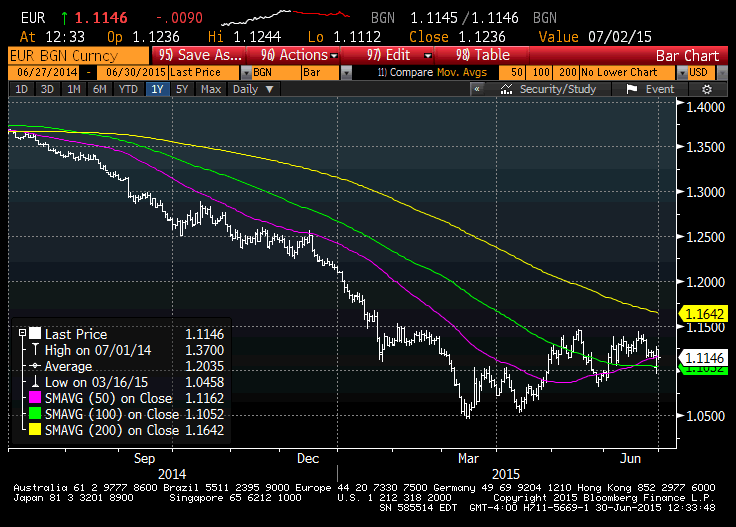Through the last half of 2014 until March of 2015, the Euro steadily sold off versus the dollar, as the ECB launched QE and European yields cratered. For example, Spain’s ten year note yield went from 2.82% in July to as low as 1.15 at its nadir March. As has been well publicized, many shorter maturity yields went negative, for example the German two year note fell to negative 28 bps. The EURUSD was above 135 in July, and fell just under 105 by the middle of March. In April, 105 was retested to the downside, after an intervening bounce to a little over 110.

Since mid-April, the EURUSD has generally firmed, as conditions stabilized economically, and inflation showed a pulse. The sideways range between early May and June has been 108.19 to 115. Now, it’s all about Greece, at least in the short term.
This past weekend, as Tsipras called a surprise referendum to be put to voters, the other 18 members of the Eurozone unanimously rejected extending aid beyond Tuesday’s IMF payment deadline. I thought that the May low of 108.19 would at least be tested early Monday morning, (Friday’s close had been 111.67), but instead, the low was only 109.55 and indeed by the end of the day the close was 112.36. It doesn’t quite square intuitively…if Greece exits the Euro, the currency should be in disarray, right? Not so fast.
The referendum is set for this weekend; the Greek populace will either accept the deal with a YES vote (trim pensions but save bank deposits…) or decline the proposals with a NO vote, and probably move to the drachma. If Greece votes “no”, then the Eurozone as a whole will be left with stronger countries. Additionally, uncertainty may increase at the margin for Emerging Market economies. The US Federal Reserve, having consistently communicated that a hike is around the corner, may once again feel that it’s handcuffed by international concerns. In this case, I actually think the EUR could ironically rally to somewhere between 118 and 120.
On the other hand, if Greece votes “yes”, then there will have to be new elections in Greece and the whole process will become drawn out. The ECB may err on the side of more largesse; the Fed may conversely feel more comfortable in moving the Fed Funds rate off the zero bound. In that case, EURUSD might probe new lows once again.
In terms of trade ideas, if you like the upside, with ECU5 trading 111.56 (mid day Tuesday) both the August expiration 115.5/116.5 call spread and the 107.5/106.5 put spread were 16/17. Close above 116.50 on the call spread by expiration (Aug 7, 2015) and the call spread will be worth 100. On the downside, if we close below 106.50, the put spread will be worth 100. On either the call spread or the put spread, the most that can be lost is that amount of premium that you pay.
The point is, it’s not always easy to tell which way the market wants to go, even if you think you have a handle on it. Especially in FX markets at a time like this, it pays to use options, and limit your exposure.
Alex Manzara




